
This page last revised 04 September 2006 -- S.M.Gon III
Introduction
Ecoregion
Conservation Targets
Viability
Goals
Portfolio
TNC Action Sites
Threats
Strategies
Acknowledgements
▫
Tables
Maps & Figures
CPT Database
Appendices
Glossary
Sources
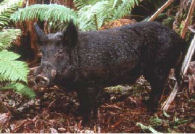
![]()
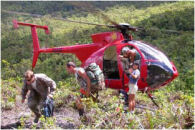
Bringing active threat abatement management to priority conservation areas isthe primary goal.
Threats
Assessing threats
The greatest, mostpervasive threats to the
The 1998 ecoregion plan identified and described the general suite of threats in theecoregion. ERA II builds on that foundation and ranks the highest priority threats foreach conservation area. Threats include some that are pervasive across all conservationareas in the archipelago and some that are specific to particular places (see table below).
Threat summary
The key stress in vegetatedecological systems in Hawai‘i is change in composition and structure,typically through simplification and loss of native diversity, followed byloss of understory (and eventually canopy) structure. The main sources ofstress include both biological and anthropogenic factors, discussed below.
Invasive alien species:
The continuing invasion of alien (non-native) weeds, predators, herbivores,pathogens, and competitors into native ecosystems is the engine that currentlydrives the Hawaiian extinction crisis.
Since the establishment offorest reserves encompassing nearly all remaining native forests during thefirst three decades of the 20th century, alien invasion — not directhabitat destruction by humans—has been the dominant threat to native speciesand ecosystems in the Hawaiian Islands.
Hawai‘i is extraordinarilyvulnerable to human-accelerated alien species invasions due to:
1) the break-down of its geographic isolation as it became the hub of Pacific travel and trade;
2) an exceptional range of hospitable habitats forinvaders to occupy.
The estimated rate for successful,new colonization of the islands by a plant or animal species before humanarrival was once every 25,000 - 50,000 years. In contrast, over the past 30 years, newlyestablished species have been recorded in Hawai‘i at the rate of once every18 days. The existing complement of established invasive aliens has the capacityto overwhelm most remaining native habitat if left unchecked.

(continued next column)
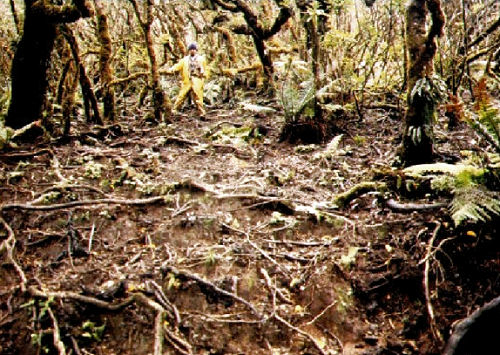
Understory obliteration by feral pigs in a montane wet forest community.
Over human history in theislands, several major groups of alien species have emerged as the mostdamaging to native ecosystems and species:
o Ungulates – lacking any large native herbivorousmammals, the Hawaiian flora is not adapted to ungulate browsing or trampling.Feral pigs, goats, sheep, deer, and cattle were responsible for destructionof lowland ecosystems, and continue to degrade remaining native ecological systems.
o Invasive weeds – through a history ofincreasing introduction of alien plants, there are now more species of naturalizedalien vascular plants in the wilds of Hawai‘i than there are native species.Perhaps 200 of these are extremely aggressive, habitat-modifying weeds.
o Predators – small mammals such as rats, mongoose,and feral cats prey on native birds. Rats are implicated as wholesalevegetation modifiers via selective seed predation. Predatory invertebratessuch as ants and other social hymenoptera have greatly disrupted invertebrate communities at allelevations, particularly in the lowlands.
For these reasons, conservationin Hawai‘i depends more than anything on keeping remaining, relativelyuninvaded native areas intact, stemming the establishment of new invasivespecies, and devising practical strategies to limit the impact ofwidely-established species.

| Threat | KAU | WAI | KOO | EMO | WMA | EMA | KOH | MK | WML | K-K | KON | P-P |
| Ungulates | H | H | H | H | H | H | H | H | H | H | H | H |
| Weeds | H | VH | VH | H | H | H | H | H | VH | H | H | H |
| Fire | L | H | M | H | M | L | L | M | L | L | H | VH |
| Small Mammals | M | H | M | L | L | M | L | M | M | M | M | L |
| Pathogens | M | L | L | L | L | M | L | M | M | M | M | L |
| Development | L | M | M | L | L | L | L | L | H | L | H | L |
| Military Training | L | H | M | L | L | L | L | L | L | L | L | H |
| Recreational Use | L | L | L | L | L | L | L | L | L | L | L | L |
| Stream Diversion | L | NA | L | L | M | M | L | M | NA | NA | NA | NA |
| Overharvesting | L | L | L | L | L | L | L | L | L | L | L | L |
| Logging | L | L | L | L | L | L | L | M | L | L | H | L |
| Grazing | L | L | L | L | L | L | M | M | L | L | H | M |
| Overall rank: | M | H | H | M | M | M | M | H | H | M | H | H |
Threat Ranks: VH = Very High, H = High, M = Medium, L = Low.
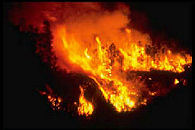 Wildfirein Hawai'i is invariably followed by invasion by fire-adapted aliengrasses and shrubs, creating a cycle of destruction for native speciesand ecosystems.
Wildfirein Hawai'i is invariably followed by invasion by fire-adapted aliengrasses and shrubs, creating a cycle of destruction for native speciesand ecosystems.
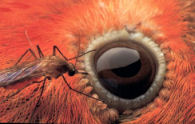
Mosquitos carry diseases such as avian malaria; deadly to endangered forest birds.
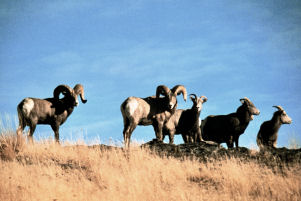
Goats and sheep are a prevailing threat to drier native areasin Hawai‘i.
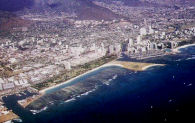
Development remains a threat on O'ahu, where 80% of the state's population resides.
Threat Summary (continued from above)
Fire: Wildfire is an uncommon natural occurrence inHawai‘i, where ground-strike lightning is rare and wet plant communities coverlarge areas. Fire-adapted aliens(especially grasses and short-lived shrubs) are established inlower, leeward slopes and some subalpine areas. Normally ignited by people, these weeds fuel major wildfires that cancarry into native forests. Native forests are destroyed and replaced with fire-adaptedweeds in a trend that increases the range and intensity of these fires.
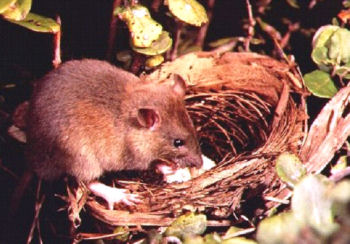
Rodents are important egg predators in forest bird concentration areas.
Small Mammals: There are no native small mammals (e.g.,rodents, cats, dogs, rabbits, mongooses) in Hawai‘i, andthe ecological effects of either herbivorous, omnivorous, or predatorysmall mammals is to reduce populations of native species, sometimes toextinction. Rodents are implicated in damage to lowland forests viaseed predation, as well as on both ground-nesting seabirds and forestbirds. Feral cats and dogs impose similar impacts. Rodents seemparticularly damaging in the Wai'anae conservation area of O‘ahu,where they affect endangered tree snails, rare native plants, and anendangered forest bird, the ‘elepaio (Chasiempis sandwichensis gayi).
Pathogens (including invertebrate pests):Diseases and pests can play an important role in reduction of viabilityof native species, and indirectly, the natural communities andecological systems comprised of these species. Pathogens and pestsrelated to declines in native species include mosquitoes andmosquito-borne diseases (avian malaria and pox), ants (various species), Erythrinagall wasp (Quadrastichus erythrinae), two-spotted leafhopper (Sophonia rufofascia), slugs (various species), andblack twig borer (Xylosandrus compactus). Often the role of pathogens is tied to otherthreats. For example, avian diseases affecting native forest birdconcentrations are spread by mosquitos, and spread of mosquitos intoforest bird habitat is tied to wallows of feral pigs that createmosquito breeding sites where none otherwise exist.Development :Widespread conversion and development of the lowlands of the Hawaiianecoregion took place from prehistoric times to the first half of thetwentieth century. Following statehood, strong conservation zoning haslargely limited development of natural areas and forest reserves, butincremental conversion of lowland native areas continues on the mostdensely populated island (O‘ahu), as well as the largest island(Hawai‘i), particularly in the Windward Mauna Loa and Konaconservation areas.
(continued next column)
Military training activities: Live-fire training, large-scale troopmovements, and heavy equipment operation are serious threats to native speciesat U.S. Army training facilities in the
Recreational use:Typical recreational uses of native ecosystems include hiking, camping,and off-road vehicle touring. Restrictions on damaging activities inthe state conservation district somewhat limits the impacts of recreational use,although indirect effects of recreational activities such as hiking, e.g., spread of invasive weeds, has been documented.
Stream diversion: Nativestream communities are highly dependent on continuous stream flows to the seato support the diadromous life cycles of their dominant aquatic animals. Most of the state’s streams are alreadypartially or fully altered (channelized, diverted, or de-watered viagroundwater pumping), and those that remain are vulnerable as the demand forfresh water outstrips the current yield of harvesting. The new Hawai‘i State Water Code providesmechanisms for protecting stream flow, but these mechanisms await their firsttest cases.
Overharvesting: Most minor forest and stream “commodities”(plant materials for lei making, flower arrangements, and herbal use; streamfishes and invertebrates for food) can be harvested for home and cultural use on asustainable basis. These activities arenot sustainable at a large, commercial scale in most situations, and arealready restricted by permit systems.
Logging: Although logging andother high-intensity harvesting is no longer widespread in Hawai‘i (mostloggable areas were cleared in the last century), these and other clearingpractices are important concerns in some conservation areas on Hawai‘i Island. Commercial logging of native koa (Acaciakoa), ‘ōhi‘a (Metrosideros spp.),sandalwood (Santalum spp.), and hāpu‘utree ferns (Cibotium spp.) areapproaching the limits of available resources, and the forest products industrysupports planting programs to restore former forest lands.
Grazing: Clearing of forest for production of cattle has a 200 yearhistory in Hawai‘i. Cattle, being large ungulates, have the samedamaging effects on native vegetation as other ungulates,and the devastating effects of cattle in Hawai'i have been welldocumented. Today, there remain large private ranches, several ofwhich occur within native ecological systems. Ranching-relatedloss of native ecosystems is active in the Kona conservation area inparticular.
![]()
